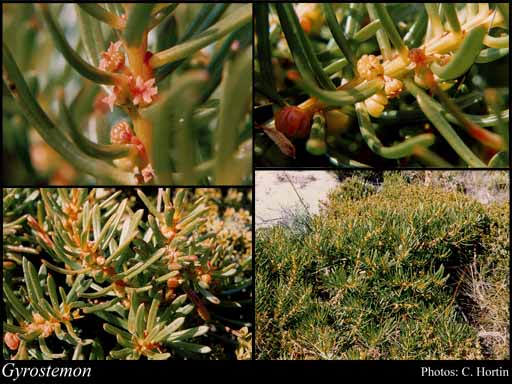- Reference
- Mém.Mus.Hist.Nat. 6:16, Tab.6 (1820)
- Name Status
- Current







Scientific Description
Family Gyrostemonaceae.
Habit and leaf form. Small trees, or shrubs. Leaves cauline. Young stems cylindrical. Stem internodes solid. Xerophytic. Leaves small, or medium-sized; alternate; spiral; fleshy, or ‘herbaceous’ to leathery; sessile; non-sheathing; simple; epulvinate. Leaf blades entire; solid; terete; linear, or lanceolate, or oblanceolate, or oblanceolate, or ovate; ovate, or obovate, or linear; one-veined, or pinnately veined. Leaves with stipules (small). Leaf blade margins entire. Leaves without a persistent basal meristem. Leaf anatomy. Hairs absent (sometimes papillose). Extra-floral nectaries absent. Stem anatomy. Secondary thickening developing from a conventional cambial ring.
Reproductive type, pollination. Fertile flowers functionally male, or functionally female. Unisexual flowers present. Plants dioecious. Female flowers without staminodes. Male flowers without pistillodes.
Inflorescence and flower features. Flowers solitary, or aggregated in ‘inflorescences’; in racemes. The terminal inflorescence unit racemose. Inflorescences axillary; racemose or spicate. Flowers pedicellate (recurved), or subsessile; ebracteate; bracteolate (2 subtending the calyx, usually minute); small; regular; cyclic. Perianth sepaline; 4–5 (if segments detectable); 1 -whorled; joined. Calyx present; 4, or 5 (when lobed); 1 -whorled; gamosepalous; blunt-lobed, or toothed; regular; persistent. Corolla absent. Fertile stamens present, or absent. Androecial members definite in number (AKP), or indefinite in number (AKP). Androecium 8–12. Androecial sequence determinable, or not determinable. Androecial members when in more than one cycle, maturing centripetally; free of the perianth; all equal; free of one another; 1–5 -whorled. Androecium exclusively of fertile stamens. Stamens 8–12 (or numerous); all more or less similar in shape; polystemonous; 8–12 in 1 whorl around the central disc on the edge of the expanded receptacle or numerous all over the central disc; filantherous (almost sessile). Anthers dehiscing via longitudinal slits; introrse. Fertile gynoecium present, or absent. Gynoecium 1–33 carpelled. The pistil 1–33 celled. Gynoecium apocarpous, or syncarpous; semicarpous to synovarious (the carpels adnate to the central column, forming a compound ovary); superior. Carpel stylate; apically stigmatic. Styles united, or free. Carpel 1 ovuled. Placentation marginal. Ovary unilocular, or plurilocular; 1–33 locular; sessile. Gynoecium stylate. Styles 1–33; free, or partially joined; apical. Stigmas 1–33. Placentation axile. Ovules in the single cavity 1; 1 per locule; apotropous; arillate; anatropous.
Fruit and seed features. Fruit fleshy (sometimes), or non-fleshy; interpretable as an aggregate (if seen as resulting from more or less ‘free’ carpels). The fruiting carpels coalescing into a secondary syncarp to not coalescing. Fruit a schizocarp. Mericarps comprising follicles, or comprising ‘legumes’ (mericarps separate from the central column and from each other, dehisce along the outer margin or along both margins). Fruit 1–33 seeded. Seeds copiously endospermic. Endosperm oily. Embryo well differentiated. Cotyledons 2. Embryo curved.
Physiology, biochemistry. Mustard-oils present.
Etymology. From the Greek for "ring" and "thread, stamen"; the stamens are twisted round one another in a circular manner.
Taxonomic Literature
- Wheeler, Judy; Marchant, Neville; Lewington, Margaret; Graham, Lorraine 2002. Flora of the south west, Bunbury, Augusta, Denmark. Volume 2, dicotyledons. Australian Biological Resources Study.. Canberra..
- Wheeler, J. R.; Rye, B. L.; Koch, B. L.; Wilson, A. J. G.; Western Australian Herbarium 1992. Flora of the Kimberley region. Western Australian Herbarium.. Como, W.A..
- Blackall, William E.; Grieve, Brian J. 1988. How to know Western Australian wildflowers : a key to the flora of the extratropical regions of Western Australia. Part I : Dicotyledons (Casuarinaceae to Chenopodiaceae). University of W.A. Press.. [Perth]..
- Marchant, N. G.; Wheeler, J. R.; Rye, B. L.; Bennett, E. M.; Lander, N. S.; Macfarlane, T. D.; Western Australian Herbarium 1987. Flora of the Perth region. Part one. Western Australian Herbarium.. [Perth]..